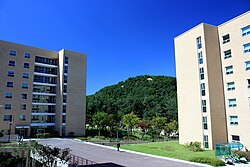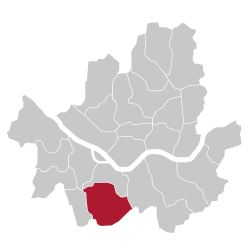Gwanak District
This article needs additional citations for verification. (June 2017) |
Gwanak
관악구 | |
|---|---|
| 관악구 · 冠岳區 | |
 | |
 Location of Gwanak District in Seoul | |
| Coordinates: 37°28′42″N 126°57′06″E / 37.4784°N 126.9516°E | |
| Country | South Korea |
| Region | Sudogwon |
| Special City | Seoul |
| Administrative dong | 21 |
| Government | |
| • Body | Gwanak-gu Council |
| • Mayor | Park Jun-hee (Democratic) |
| • MNAs | List of MNAs |
| Area | |
• Total | 29.57 km2 (11.42 sq mi) |
| Population (2010[1]) | |
• Total | 520,849 |
| • Density | 18,000/km2 (46,000/sq mi) |
| Time zone | UTC+9 (Korea Standard Time) |
| Postal code | 08700 – 08899 |
| Area codes | +82-2-5xx, 8xx |
| Website | Gwanak District official website |
 | |
Gwanak District (Korean: 관악구; RR: Gwanak-gu) is an administrative subdivision (gu) of Seoul, South Korea. It lies on the southern skirt of Seoul, bordering Anyang of Gyeonggi Province. The southern border of Gwanak District, bordering Anyang, consists of the craggy ridgeline of Gwanaksan (Mt. Gwanak), which dominates the local geography.
Originally a part of Siheung, Gyeonggi, it was transferred to Seoul with the rapid expansion of the National Capital Area and its population growth in 1960s. Partitioned from Yeongdeungpo District and established as a district in 1973, it now neighbours the Seocho, Dongjak, Guro, and Geumcheon Districts, and exercises jurisdiction over 21 neighborhoods (dong), with a population of 500,000.
Overview
Gwanak District is densely populated with over 500,000 people. While it was once a rural area dominated by the presence of Gwanaksan (Mt. Gwanak), population booms in the late 1950s and early 1960s, accompanied by rapid industrialization of the capital area, quickly changed the town into a mosaic of dense residential and industrial areas. Large slum quarters were formed by migrant populations from all over Korea who sought jobs in industrialized Seoul. A series of redevelopment projects starting in the 1970s, and the relocation of Seoul National University to the district, led to a reduction of slum quarters and indigent textile industries and transformed the town into a residential uptown neighborhood of Seoul. The area is also heavily populated by university students from surrounding provinces.
Commercial zones
Central commercial zones include the Seorim and Daehak area and the Cheongnyong area near Seoul National University. These areas also form a large zone of private dormitories and small houses, which primarily target university students and national examination takers (gosi-saeng) looking for an environment that is favorable for studying. Restaurants, supermarkets, bars and pubs in the area are centered in Nokdu Street (Nokdu-geori) in the Daehak area and near Seoul National University Station. Other commercial zones for residents are located along the Nambu Beltway and two main roads.
The main shopping district, the Bongcheon Central Market (Bongcheon-jungang-sijang), is positioned in Jungang neighborhood, north from Seoul National University Station.
Transportation
Nambu Beltway, which circles Seoul, passes through the very center of the district. The beltway and two main avenues, Gwanak Road (Gwanak-ro) and Sillim Road (Sillim-ro), make the main route of the automobile traffic. Nambu Beltway is connected to multiple expressways.
Public transportation
Green Line (Line 2) and Blue Line (Line 4) of Seoul Metro links Gwanak District and other areas. Many trunk (painted in blue) buses such as 501, 506, 651 and 750 lines, and branch (in green) buses in 5XXX or X5XX line passes Gwanak area.[2]
Metro stations
- Seoul Metro (Seoul Metropolitan Rapid Transit Corporation)
- Seoul Subway Line 2 (Green Line)
- (Dongjak) ← Nakseongdae — Bongcheon — Sillim → (Dongjak)
- Seoul Subway Line 4 (Blue Line)
- Seoul Subway Line 2 (Green Line)
Administrative divisions

There are three statutory subdivisions: Sillim, Bongcheon and Namhyeon neighborhood. Those are further divided into multiple administrative neighborhoods (dong) to balance excessive populations and for administrative expedience. As of September 2008, there are 21 administrative neighborhoods in Gwanak District.[3]
| Statutory neighborhood | Administrative neighborhood | Hangul | Hanja |
|---|---|---|---|
| Sillim | Seowon | 서원 | 書院 |
| Sinwon | 신원 | 新源 | |
| Seorim | 서림 | 西林 | |
| Nangok | 난곡 | 蘭谷 | |
| Sinsa | 신사 | 新士 | |
| Sillim | 신림 | 新林 | |
| Samseong | 삼성 | 三聖 | |
| Nanhyang | 난향 | 蘭香 | |
| Jowon | 조원 | 棗園 | |
| Daehak | 대학 | 大學 | |
| Miseong | 미성 | 美星 | |
| Bongcheon | Euncheon | 은천 | 殷川 |
| Seonghyeon | 성현 | 成賢 | |
| Cheongnyong | 청룡 | 靑龍 | |
| Boramae | 보라매 | No hanja notation | |
| Cheongnim | 청림 | 靑林 | |
| Haengun | 행운 | 幸運 | |
| Nakseongdae | 낙성대 | 落星垈 | |
| Jungang | 중앙 | 中央 | |
| Inheon | 인헌 | 仁憲 | |
| Namhyeon | Namhyeon | 남현 | 南峴 |
Points of interest

- Seoul National University
- Seoul Museum of Art, South Branch (SeMA Nam-Seoul)
- Former Belgian Consulate Building
- Horim Museum
- Nokdu Street
- Nakseongdae
- Anguk Shrine
- Gwanaksan (Mt. Gwanak)
- Gwaneum-sa Buddhist Temple (in Gwanaksan Park)
Sister cities
 Daxing, Beijing, China
Daxing, Beijing, China Tiexi, Shenyang, China
Tiexi, Shenyang, China Royal Kingston, London, United Kingdom
Royal Kingston, London, United Kingdom Montgomery County, Pennsylvania, United States of America
Montgomery County, Pennsylvania, United States of America
Notable people from Gwanak District
- Kang Kam-ch'an, Korean medieval government official and military commander during the early days of Goryeo Dynasty
- Yang Jungwon (정원), singer, dancer and K-pop idol, leader and member of K-pop boygroup ENHYPEN
- Solji (Real Name: Heo Sol-ji, 허솔지), singer, dancer, model and K-pop idol, leader and member of K-pop girlgroup EXID and former member of ballad duo group 2NB
- Taeyong (Real Name: Lee Tae-yong, 이태용), singer-songwriter, rapper, dancer and K-pop idol, leader and member of K-pop boygroup NCT, of its subunits NCT U and NCT 127 and member of the K-pop superboygroup Super M
- Hong Eun-chae (홍은채), singer, dancer, and K-pop idol, member of girlgroup Le Sserafim under Source Music, and current host of KBS Music Bank[4]
See also
References
- ^ "A Korean Statistical Information Service (Korean) : Population and Household : Census Result (2010) : Population by Administrative district, Sex and Age / Alien by Administrative district and sex". Kosis.kr. Retrieved 2 June 2010.
- ^ "Seoul Metropolitan Government – "A Clean, Attractive & Global City, Seoul!"". Archived from the original on 23 August 2008. Retrieved 23 August 2008.
- ^ [서울신문] "봉천동은 이제 잊어주세요". Seoul Shinmun. Retrieved 17 June 2017.
- ^ 20대 아이돌과 27년 전 아이돌 (Feat. 르세라핌), retrieved 11 September 2023


